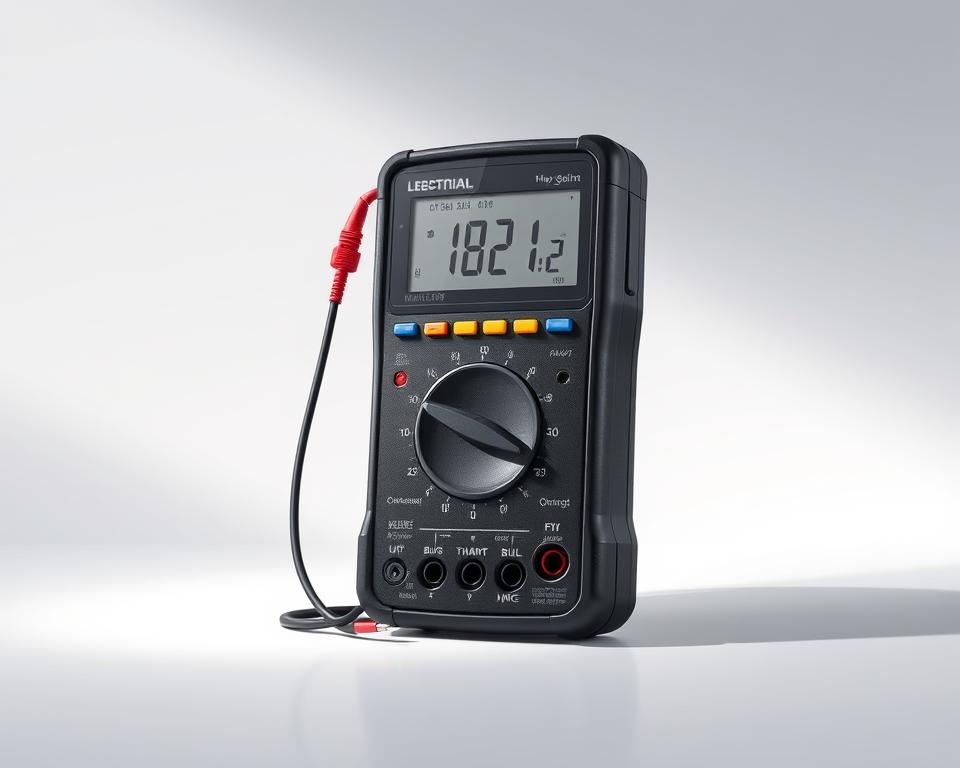Multimeter Applications: Fundamental Capabilities Explained
The average multimeter can measure up to 20V in potential readings. Yet many initiatives, notably in innovation and tech circuits, utilize less than 200mA of current. This fact underscores the critical role multimeters serve in electronic diagnostics and fault finding. Understanding how to use a multimeter is imperative, not just for experts and engineers, but also for pupils examining circuit theories.
Multimeters are indispensable in their adaptability, offering accurate measurements of voltage, current, and resistance. This piece will investigate the various roles and functions of a Cen Tech 7 function digital multimeter. It seeks to supply you with the understanding to successfully use this essential tool in your electrical experiments and initiatives.
Salient Features
- Multimeters are key instruments for measuring voltage, current, and resistance.
- Understanding multimeter applications is crucial for successful troubleshooting.
- Digital multimeters are well-regarded for their clarity and exactness in measurements.
- Safety precautions are essential when employing a multimeter for electrical testing.
- Continuity assessment is an important capability for checking electrical connections.
- Selecting the proper multimeter can notably influence your diagnostic productivity.
Introduction to Multimeters
A multimeter is indispensable for troubleshooting electrical problems and guaranteeing devices function properly. It measures various electrical characteristics, crucial for both specialists and hobbyists.
Explaining a Multimeter?
A multimeter integrates instruments to assess electrical potential, current, and resistance. This aids significantly in resolving electronic faults. Available in analog and digital versions, multimeters are crucial. Analog types use a pointer and dial for gauging, whereas digital ones display values on a display. They evaluate wall outlets, batteries, and various gadgets.
Importance of Multimeter in Electronic Evaluation
In electrical testing, the role of a multimeter is of utmost importance. It assesses system continuity and identifies faults in various settings. For example, in the auto industry, it evaluates battery potential and sensors. It also confirms industrial machinery functions seamlessly, avoiding costly breakdowns.
Multimeters, crucial for testing, assess AC and DC voltage, current, and resistance. Their ability to handle varied tasks makes them irreplaceable for both simple and advanced projects.
Types of Multimeters
Understanding the multiple types of multimeters is essential for efficient electrical testing. They are divided into two primary classes: analog and digital multimeters. Each offers distinct attributes and advantages. Therefore, choosing the suitable type relies on your particular needs and preferences.
Analog Multimeters
Analog multimeters boast a dial indicator and dial display. They are excellent for tracking quickly varying measurements. Their configuration lets users to see variations as they transpire. Analog devices feature a measurement span typically between 1K to 50K Ω/V, with the maximum sensitivity reaching 20K Ω/V. This made them preferred tools for radio technicians in the 1950s era.

Digital Multimeters
Due to their exactness and performance, digital multimeters have become highly favored. Their LCDs present readings clearly and can display up to four digits. They can assess various attributes like voltage and temperature. Furthermore, premium models feature auto-ranging, data logging, and wireless connectivity. This renders them well-suited for complex applications in fields like car troubleshooting and sustainable energy.
Contrast of Traditional and Digital Multimeters
Choosing between traditional and digital multimeters depends on your specific requirements and financial plan. The table below details their primary distinctions:
| Characteristic | Traditional Multimeters | Electronic Multimeters |
|---|---|---|
| Screen | Needle pointer on dial | LCD screen (LCD) |
| Measurement Accuracy | Adequate, but somewhat lower in precision | High precision and resolution |
| Response Time | Quick response to fluctuations | Relies on data acquisition speed |
| Applications | Best for fast-shifting readings | Adaptive, used in multiple sectors |
| Price | Usually more affordable | Ranges significantly, but can be more costly |
Although both multimeter types are vital for electrical testing, digital multimeters’ exactness and capability have rendered them more favored among operators in both retail and professional spaces.
Elements of a Multimeter
Grasping the key elements of a multimeter is important for its efficient use. It comprises various main components, each with a unique role. The screen delivers readings, while the function selector enables users to alternate between functions like voltage, current, and resistance. Probes connect the device to the circuit being examined, representing another vital feature.
Essential Components and Their Functions
The essential parts of a multimeter are segmented into:
- Display Panel: Shows values in real-time for simple analysis.
- Function Selector: Lets users choose the mode, including voltage, current, or resistance functions.
- Ports: Usually three, but some models have 4 for connecting multiple probes.
- Test Probes: Critical for attaching the multimeter to circuitry, with red for positive and the black probe for ground connections.
Grasping Multimeter Probes
Probes are essential in multimeter operation. They are available in different types, such as standard or alligator clips. The red probe is used for testing electrical potential or resistance; the black serves as a ground. Using alligator clips simplifies tasks pertaining to multiple components, boosting measurement precision and effectiveness.
Mechanics of the Selection Knob
The selection knob is crucial for navigating the device’s functions. By twisting the knob, users can shift between AC and DC voltage assessments, current measurement, or resistance testing. Choosing the appropriate setting is vital for exact readings. Users must exercise caution with the range setting to avoid device harm or miscalculations.
Functions of a Multimeter
For anyone involved in electrical testing, familiarity with the multimeter’s operations is vital. These devices provide critical assessments for precisely assessing electrical elements. They gauge voltage, assess current, and verify resistance, rendering them indispensable for both expert usage and DIY projects.
Gauging AC and DC Voltage
Measuring both AC and DC voltage is a fundamental function of multimeters. They offer superior accuracy, with the capability to discern minor changes. This is crucial for confirming that electrical devices run safely within their voltage limits.
Evaluating Current Measurement
Current measurement is more complex than voltage. You must disrupt the circuit path where you want to determine, as the multimeter is connected in series. Choose the appropriate range, marked in amperes or milliamps. Securely attach the multimeter probes between the open points of the circuit.
Grasping Resistance Measurement
Testing component functionality, such as resistors and capacitors, is performed via resistance measurement. Multimeters can measure resistance up to a range of megaohms, which is crucial for assessing circuit integrity and executing continuity tests.
Continuity Testing Capabilities
Continuity testing is crucial for troubleshooting. It utilizes audible beeps or display cues to signal electrical connections. This secures that circuits function as intended, aiding in effective diagnostics.
| Capability | Traditional Multimeters | Electronic Multimeters |
|---|---|---|
| Voltage Measurement | Measures AC and DC voltage with remarkable exactness | Evaluating energy source in devices |
| Current Measurement | Assesses flow of electricity in circuits | Checking battery voltage and sensor operation |
| Resistance Measurement | Tests the performance of circuit components | Ensuring resistors and diodes are operating within specifications |
| Continuity Testing | Verifies electrical connections | Assessing circuit integrity |
Using a Multimeter Safely and Properly
Understanding how to operate a multimeter is vital for anyone involved with electrical systems. Proper procedures ensure protection and precise readings. When measuring voltage, current, or resistance, each step demands specific safety measures.
Basic Safety Measures
Learning safety measures before employing a multimeter is essential. Your multimeter should be suitable for your operating conditions. Regrettably, over 30% of electricians use substandard tools, risking danger. To work securely, always confirm the multimeter is set correctly before linking probes.
Procedure for Assessing Voltage
Measuring voltage necessitates careful precision. First, determine the appropriate multimeter range for the voltage, AC or DC. Insert the probes into the designated ports: the common and voltage-specific connectors. Then, affix the probes accurately to the circuit.
How to Measure Current
Current measurement is more complex than voltage. You must interrupt the circuit path where you want to determine, as the multimeter joins the circuit in series. Choose the correct range, marked in amps or milliamps. Securely attach the multimeter probes between the discontinuities of the circuit.
Procedure for Evaluating Resistance
To precisely evaluate resistance, detach the component in question. Switch the multimeter to resistance mode, then attach the probes to the component. A matching reading signifies that the component works well; otherwise, it might be malfunctioning. This precaution mitigates multimeter damage and secures correct electrical flow analysis.
Frequent Uses of Multimeters
Multimeters are essential in both commercial and domestic contexts for a variety of functions. They stand out in diagnosing electrical circuits, rendering them priceless. These devices are key in detecting and repairing electrical problems, guaranteeing systems work as they should.
Troubleshooting Electrical Issues
Multimeters primarily help in diagnosing electrical circuit issues. Technicians and DIY enthusiasts use them to pinpoint problems. By assessing voltage, current, and resistance, they identify faulty parts, guaranteeing safe and efficient operation.
Testing Batteries and Power Sources
Assessing batteries is a crucial application for multimeters. They assess voltage to assess automotive or household battery state of charge. This allows users to ascertain if a battery is functioning properly or is failing, improving energy management.
Checking Circuit Integrity
For optimal operation, assessing circuit integrity is essential. Multimeters evaluate this by examining continuity and resistance. They identify issues such as broken wires or defects, leading to timely fixes. Overall, multimeters improve both the safety of installations and circuit troubleshooting.
Choosing the Appropriate Multimeter for Your Requirements
Choosing the suitable multimeter improves your effectiveness in electrical testing. Key factors to consider include precision, range of measurements, portability, and ease of use. Unlike analog meters, digital multimeters outperform in functionality, preferred by technicians and hobbyists.
Key Considerations
Essential factors in selecting a multimeter include:
- Accuracy: Digital multimeters provide high precision, capable of registering 1 millivolt.
- Measurement Ranges: Select models that support various electrical measurements like voltage, current, and resistance.
- Compactness: Select compact, easy-to-carry designs for portable use.
- Ease of Use: Auto-ranging and illuminated screens make for a better user experience.
Favored Options: Cen-Tech 7 Function Digital Multimeter
The Cen-Tech 7 Function Digital Multimeter is recognized for its versatility and affordability. It integrates key features suited for both novices and experts. Additionally, its automatic ranging feature streamlines measurements, enhancing task execution.
This model’s count capacity extends to 20,000, ensuring precise readings for a variety of electrical jobs. It is outstanding for troubleshooting, automotive tests, and battery checks. Its combination of essential features and simplicity of use makes the Cen-Tech 7 Function Digital Multimeter a preferred option for a new investment.
In Summary
Grasping multimeter capabilities is key for those engaged in electrical tasks. We’ve encapsulated multimeter applications, emphasizing their importance in testing and safety. Their precision in measuring voltage, current, and resistance is priceless. Thus, multimeters are vital for both professionals and hobbyists.
Multimeters exceed mere measurements. They deliver advanced capabilities like data logging and wireless connections. These features enable wide-ranging applications, from car diagnostics to utilizing renewable energy. Additionally, functions for continuity and frequency checks are instrumental in detecting defects, ensuring systems function reliably.
Armed with this knowledge, individuals can adeptly use their multimeter proficiency for accurate fault detection and boosting protection. They can also enhance the efficiency of electrical setups and maintenance. Essentially, multimeters’ flexibility renders them irreplaceable in achieving meticulousness in electrical jobs.
FAQ
Which main functions does a multimeter serve?
A multimeter mainly gauges voltage (AC and DC), current, and resistance. It also performs continuity tests. These operations are essential for finding electrical problems and verifying electrical continuity.
How do I choose between an analog and a digital multimeter?
Choosing between analog and digital multimeters relies on your requirements. Analog types are great for showing rapid value fluctuations. In contrast, digital models offer precise numeric readings. This makes them preferred for daily tasks.
What safety precautions should I take when using a multimeter?
When using a multimeter, always select the correct setting before connecting. Refrain from handling live wires when assessing current. Also, disconnect parts before resistance tests to prevent inaccurate readings.
Does a multimeter assess battery performance?
Yes, battery testing is a typical function for multimeters. They gauge voltage to display charge level. This ensures that your power sources are dependable for various needs.
What is continuity testing, and why is it important?
Continuity testing checks electrical connections in a circuit using a multimeter. It’s vital for identifying and repairing discontinuities. This ensures that your electrical setups operate as intended.
Which components are usually included in a multimeter?
A multimeter typically includes a measurement screen, a mode dial, input terminals, and the probes. The probes interface with the circuit being evaluated.
How does the Cen-Tech 7 Function Digital Multimeter measure up against other options?
The Cen-Tech 7 Function Digital Multimeter is simple to operate and provides a range of capabilities, including auto-ranging. It’s affordably priced, making it a wise selection for professionals and enthusiasts.


